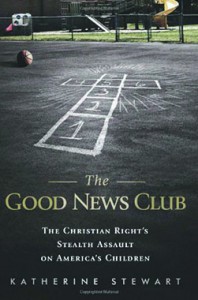The Good News Club: The Christian Right’s Stealth Assault on America’s Children

When Katherine Stewart first saw a program called the “Good News Club” on the list of available after-school activities at her daughter’s public elementary school in Santa Barbara, California, she didn’t give it much thought, except to note that the club was billed as a nondenominational Bible study program. “I soon found out, however, that the Good News Club is very different from what it appears to be,” she writes in her book, The Good News Club: The Christian Right’s Stealth Assault on Children. “More importantly, I discovered that the Club is really just one small part of a much larger story that should be of concern to anyone who cares about the future of public education—or indeed the future of secular democracy—in the United States.”
In her extensive investigative reporting, Stewart describes a plan that, for its cupidity could bring charges of fraud in our (allegedly demonic) secular world but that seems wholly holy in the evangelical one. It has as its mission the subversion—and if that fails, the disappearance—of the public school.
Calling itself a grassroots project, the Good News Club already exists in several thousand U.S. elementary schools. While the clubs claim to be local initiatives, Stewart found in her investigation that “the ideas, the money, the legal firepower that make them possible are national.” She identifies conservative legal groups such as the Alliance Defense Fund, Liberty Counsel, and the American Center for Law and Justice as “groups whose leaders write the scripts that are followed in classrooms, playgrounds, and courtrooms from New York to California … that with combined budgets totaling over $100 million per year have masterminded the religious assault on public education.”
The Child Evangelism Fellowship (CEF), which sponsors the Good News Club, is the international evangelical nonprofit behind this plan and is proud of its success evangelizing and “discipling” children (read: teaching them to proselytize other children) for over seventy years. Its publication catalogue includes offerings like Special Agents for Christ: Kids Reaching Kids, described as six upbeat training sessions in which “kids will learn the Gospel message, use the GF2 [Gospel Flipper-Flapper], see demonstrations of a child like them sharing the Gospel, practice sharing the Gospel with a friend and be challenged to become ‘special agents’ winning their world for Christ!” The Special Agent Codebook is also offered to “give kids an easy-to-use and fun reference helping them remember the important points of the Gospel message. The fill-in-the-blank format solidifies their learning.”
The purpose of CEF and its associates no doubt seems pure to them—save the sinner. But they ignore a bit of theological (even of secular) wisdom, that the road to hell is paved with good intentions. Few of CEF’s activities benefit from what we know about how children grow and learn. As method and model, they appeal to baser motives of human conduct, such as self-righteousness, elitism, and bribery, in order to achieve one’s ends, and dishonesty in order to convert the other to one’s purposes. At the same time the Good News Club and its evangelical colleagues condemn as immoral liberal religion, nontheists, humanists, and anyone else challenging their worldview. Stewart’s book is a case study of the righteous lie and its dangers.
In Chapter 10 of The Good News Club, titled “The Peer-to-Peer Evangelism Loophole,” Stewart describes deliberate and skillfully camouflaged efforts that go beyond the elementary school level. These include the Fellowship of Christian Athletes, which promotes regular prayer as part of its activities. Another example is the Life Book Movement, a project of Gideons International, by which Bibles and related material are given to Christian high school students to pass out to classmates, thereby staying within the law since the books aren’t being distributed by school staff or other adults. “It’s like we’re helping students smuggle God’s Word into a closed country (public high schools) to reach an unreached people group because studies show that only 4 percent of today’s teenagers are Bible-believing Christians,” Life Book President and CEO Carl Blunt was quoted as saying by the Christian Broadcasting Network’s Church Watch blog.
 The First Amendment to the U.S. Constitution reads: “Congress shall make no law respecting an establishment of religion, or prohibiting the free exercise thereof; or abridging the freedom of speech, or of the press; or the right of the people peaceably to assemble, and to petition the Government for a redress of grievances.”
The First Amendment to the U.S. Constitution reads: “Congress shall make no law respecting an establishment of religion, or prohibiting the free exercise thereof; or abridging the freedom of speech, or of the press; or the right of the people peaceably to assemble, and to petition the Government for a redress of grievances.”
In forty-five words, freedom of religion, speech, press, assembly, and petition are protected. In the many more words typical of attorney and judge, the meaning, history, intention, and justice of these words never ceases to be argued. In Chapter 4, “The Originalists’ New Theory,” Stewart looks at how, in the quarrel between freedom of religion and freedom of speech, the First Amendment becomes its own enemy. She begins with Widmar v. Vincent, a 1981 case on which the Supreme Court ruled 8-1 “that the exclusion of the religious group [from college campus facilities] amounted to an impermissible violation of that group’s free speech rights. The case was noteworthy because it suggested that matters involving religion and education could be judged on free speech grounds.” This led to the thinking, Stewart writes, that “the proper way for the state and its schools to remain neutral about religion is not, as the postwar consensus maintained, to exclude religion altogether, but rather to include religion in any and all forms on a par with secular viewpoints on all subjects.”
After discussing a number of cases from the 1990s, many argued before the Supreme Court by the lead attorney for the American Center for Law and Justice, Jay Sekulow, Stewart arrives at the 2001 decision in Good News Club v. Milford Central School. Here the court ruled 6-3 in favor of the Good News Club, which had been denied access to the public school’s grounds in upstate New York to establish a Club.
“The judicial strategy of the Christian Right advanced by people like Sekulow and validated by judges like [Antonin] Scalia and [Clarence] Thomas, considered in most general terms, amounts to an effort to turn civil rights law on its head,” Stewart declares. “It is an attempt to use the principle of tolerance to secure a place for intolerance, discrimination, and religious bigotry in the public schools and elsewhere. It is an attempt to protect the right of one group within society to take away the rights of others. So far, it has been working very well.”
In voicing her alarm at the success of the evangelical Christian right to infiltrate public schools in the United States, Stewart is careful to characterize many of those she came to know in her research as “caring and generous individuals who shared moments of their lives and taught me a great deal.” And while she’s sure many of them mean well for the children in their care, she concludes:
that all of their good intentions have been harnessed in service of a national agenda that will ultimately erode our communities and undermine our public schools. The goal of the national movement behind the assault on public education is to turn America into a “Christian Nation.” I am not worried that they might succeed. I am worried about the damage that they will cause when they fail, as I suspect they will in a society as inherently open and pluralistic as ours. And I am alarmed that we have allowed them to get so far so fast.
Indeed, it seems to have happened so fast that I somehow missed all the church/state opinions that have permitted the evangelical right to claim legality as it invades the public school. Hence, my gratitude to Katherine Stewart even if I come late to the party. The Good News Club offers a wealth of information and insight, written clearly and responsibly. My confession of ignorance is further grounds for recommending it, since I suspect that I am not alone.![]()
